Do you have a question about the Olympus CAMEDIA C-4040 Zoom and is the answer not in the manual?
Identifies and describes the various physical components of the camera.
Explains the function and behavior of the orange lamp in the viewfinder.
Describes the green lamp's role in focus and card status indication.
Indicates the area for autofocus targeting in the viewfinder.
Displays icons and their meanings for flash modes.
Details the battery status indications on the control panel.
Indicates a problem detected with the memory card.
Shows indication when white balance is set to non-AUTO modes.
Displays the current camera shooting mode (P, A, S, M, Movie).
Shows the currently set aperture value for the shot.
Displays the currently set shutter speed for the shot.
Indicates the current brightness compensation value.
Displays the number of still pictures that can be taken.
Indicates when the manual focus function is active.
Shows the amount of used and available space on the built-in memory.
Indicates when AE lock or AE memory is active for exposure control.
Displays the selected drive mode (single-frame, sequential, etc.).
Shows the selected white balance setting.
Displays the selected ISO sensitivity value.
Shows the selected image recording mode.
Displays battery status during playback.
Indicates when print reserve settings are applied to a picture.
Shows when a picture is protected from deletion.
Initial steps and setup procedures before using the camera.
Instructions for attaching the camera strap.
Steps for inserting batteries into the camera.
Information about SmartMedia cards and their usage.
How to turn the camera on and off.
Guide to setting the camera's internal clock and date.
Correct grip techniques for stable camera operation.
Provides the simplest methods for shooting and playback.
Basic steps for capturing still photographs with the camera.
Instructions for recording video clips with the camera.
How to quickly view captured still images.
Steps for deleting unwanted images from the camera.
Explains the camera's menu system and how it operates.
Explanation of the camera's menu system and its operation.
Description of the initial menu screen displayed upon accessing menus.
Details on accessing and using the main mode menu functions.
Explanation of how to navigate through different tabs within the menus.
Process for choosing, configuring, and saving camera settings.
Settings for drive modes like single-frame, sequential, and bracketing.
Options for adjusting camera sensitivity to light (ISO).
Selection of exposure modes: Aperture, Shutter Priority, Manual.
Setting for metering brightness across multiple points in the scene.
Selection of image quality and compression settings.
Settings for adjusting white balance based on lighting conditions.
Adjusts the sharpness of images.
Resets camera settings to default or custom saved states.
Assigns frequently used functions to shortcut menus.
Assigns a function to the custom button.
Displays options for drive mode settings accessible via shortcut.
Shows shortcut access to record mode settings.
Shortcut access to white balance adjustment options.
Records sound while shooting movies.
Sets the image recording mode and quality.
Adjusts white balance based on lighting conditions.
Allows playback and editing of recorded movies.
Explains the fundamental techniques for taking good pictures.
Explains how to select shooting modes using the mode dial.
Details on using exposure modes A, S, and M.
Instructions for recording video clips with the camera.
Detailed steps for setting aperture in Aperture Priority mode.
Detailed steps for setting shutter speed in Shutter Priority mode.
Guide to setting both aperture and shutter speed in Manual mode.
How to half-press the shutter for focus and exposure lock.
Steps to fully press the shutter to capture an image or start recording.
Explanation of how the camera's autofocus system works.
Troubleshooting tips for autofocus issues with challenging subjects.
Techniques for locking focus on subjects outside the AF target mark.
How to select the autofocus area (iESP, SPOT).
Explanation of the continuous autofocus feature.
Detailed steps for using manual focus when autofocus fails.
Guide to shooting still images using the camera's viewfinder.
Guide to shooting still images using the LCD monitor.
Advantages and disadvantages of using the viewfinder versus the monitor.
Half-press shutter for focus and exposure lock during movie recording.
Steps to start movie recording and capture sound.
How to stop movie recording and save the footage.
How to use the zoom lever for telephoto and wide-angle shots.
Instructions for enabling and using digital zoom.
Automatic flash firing in low-light or backlight conditions.
Mode to minimize red-eye effect by using pre-flashes.
Flash fires regardless of light to fill shadows or correct color casts.
Disables the flash for natural-looking twilight or night scenes.
Explanation of slow sync flash modes for background illumination.
Flash fires just before shutter closes for motion effects.
Combines slow sync with red-eye reduction for night portraits.
How to select different flash modes (Auto, Fill-in, Slow Sync, Off).
Table showing flash mode settings by mode dial.
How to adjust the amount of light emitted by the flash.
Explains advanced shooting methods for creative pictures.
How to capture a rapid series of shots.
Captures multiple shots with varying exposure settings automatically.
Explains different methods for measuring scene brightness.
How to lock exposure settings for consistent results.
Guide to photographing subjects at very close distances.
Applying special effects like B&W or Sepia during shooting.
Instructions for capturing wide panoramic images.
How to record audio with still photographs.
Covers settings to enhance image quality and control exposure.
Options for image quality settings (TIFF, SHQ, HQ, SQ).
Feature to increase resolution for larger prints.
Adjusting camera sensitivity to light (ISO settings).
Manually adjusting image brightness.
Adjusting color balance to match lighting conditions.
Fine-tuning white balance settings.
Adjusts the sharpness of images.
Explains how to play back images and movies, and use playback functions.
How to view still images on the camera's monitor.
Viewing individual pictures one by one.
Quickly viewing images without switching modes.
Displays pictures sequentially automatically.
How to play back recorded movie clips.
Displays movies as indexes of still frames for selection.
Allows editing movies by erasing unwanted sections.
Controls how much shooting data is shown during playback.
Enlarging images on the monitor for detailed viewing.
Attaching or changing sound for still pictures.
Prevents pictures from accidental deletion.
Deletes individual pictures displayed on the monitor.
Erases all pictures on the memory card except protected ones.
Steps for connecting the camera to a television for playback.
Navigating through images for TV playback.
How to rotate images for playback on a TV.
Explains various useful camera functions and menu operations.
Assigning functions to the custom button for quick access.
Steps to configure the custom button's function.
Customizing shortcut menus for faster access to functions.
How to use the self-timer for capturing photos with the photographer included.
Resets camera settings to default or custom configurations.
Feature to check CCD and image processing circuits.
Selection of units for manual focus display.
Prepares pictures for printing at photo labs or printers.
Information on preparing and printing images.
Sets print data for all pictures on the card.
Sets print data for individual pictures.
Allows cropping and resizing images before printing.
Clears all print reserve settings from the card.
Shows how to transfer images to a computer for viewing/processing.
Instructions for connecting the camera to a PC via USB.
Steps to install necessary drivers for Windows 98/98SE.
Process of copying images from the camera to a computer.
Safe procedure for removing the memory card after transfer.
Safe procedure for disconnecting the USB cable.
Information on using optional accessories with the camera.
How to connect and use the AC adapter for continuous power.
Information on using external flash units with the camera.
Specific instructions for the FL-40 external flash.
Guidelines for using third-party external flashes.
How to operate the camera remotely using a remote control.
Includes troubleshooting, error codes, and other helpful information.
Common camera problems and their solutions.
Guidance on cleaning and maintaining the camera.
Explanations of camera error codes and corrective actions.
Technical details and features of the camera.
Definitions of technical terms used in the manual.
| Image Sensor | 1/1.8" CCD |
|---|---|
| Storage | SmartMedia card |
| Digital zoom | 2.5 x |
| Image sensor size | 1/1.8" |
| Sensor Type | CCD |
| Image Resolution | 2272 x 1704 pixels |
| Lens | 3x optical zoom lens |
| Display | 1.8" LCD monitor |
| ISO Range | 100, 200, 400 |
| Shutter Speed | 16 - 1/1000 sec |
| Battery | Lithium-Ion LB-01 |
| Camera type | Digital camera |
| Optical Sensor Resolution | 4.0 MP |
| Viewfinder Type | Optical viewfinder and LCD |
| Effective Pixels | 4.0 MP |
| Shutter Speed (extended) | 16 - 1/1000 sec |
| LCD Monitor | 1.8-inch |
| File Formats | JPEG, TIFF |
| Lens (mm) | 7.1 - 21.3mm (35mm equivalent: 35 - 105mm) |
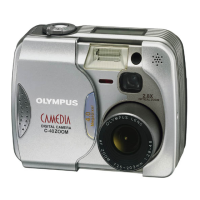
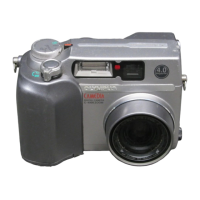
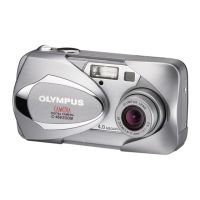



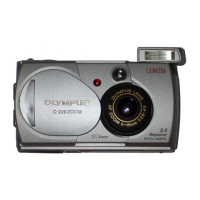

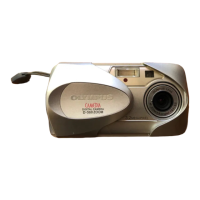
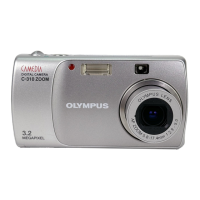
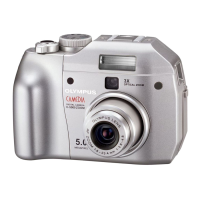
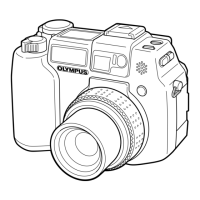
